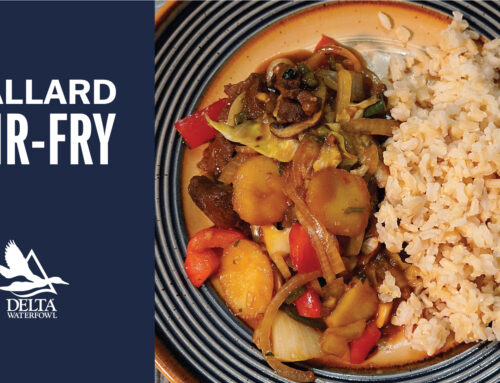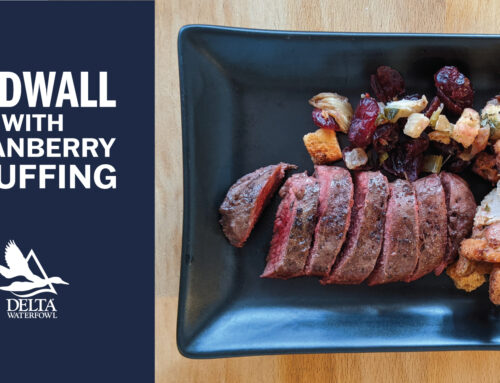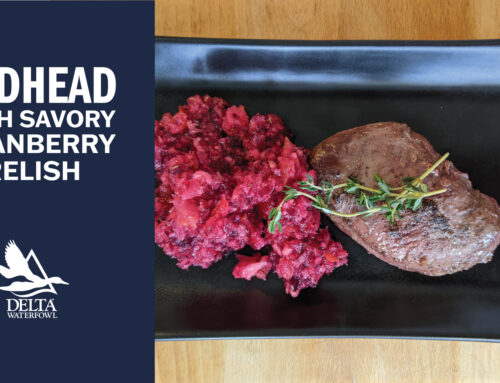Bacon and Fire
By Tyler Shoberg
Bacon and Fire. A great combination! Smoked Spanish paprika? Black truffle oil? Were these actual ingredients for a waterfowl recipe? Or requirements for a magic potion?
I shook my head and flipped to the next page in the wild game cookbook. Of the hundreds of recipes in the heavy volume, I’d yet to stumble across a single one that didn’t require taking out a second mortgage in order to afford the list of exotic ingredients.
With a huff, I slammed the cover closed and tossed it on a lofty pile of similar cookbooks.
Another bust.
Well, it looked like my duck dinner would be an old standby — the simplest and tastiest catchall recipe known to man that required just two critical components: Bacon and fire.
The method is as easy as the ingredients.
1) Wrap meat hunks, either whole duck breasts or similarly sized cut-up goose breasts, in pieces of bacon.
2) Secure with toothpicks.
3) Cook over open flame (grill, BBQ pit, campfire, BIC lighter, etc.).
That truly is all it takes to whip up a delicious main dish. It will make a believer out of even the most adamant wild game haters, and works equally well on just about any finned, furred or feathered beast (FYI: Bacon-wrapped sharp-tailed grouse is roll-your-eyes-back good.)
In fact, if more people’s first tastes of duck or goose were this recipe, I’d reckon we’d have a few more waterfowlers within our ranks. I mean, aside from the investment in equipment, one reason waterfowl hunting participation numbers have dropped in recent years likely can be attributed to taste. Simply put, folks don’t like to eat the birds we love to hunt.
Granted, a lean, grizzled-up Canada goose takes some finesse to properly prepare, but I’ve yet to find waterfowl that doesn’t become palatable once wrapped in cured pork and cooked over hot coals.
The concept of bacon and fire is better if you prefer to shop for bargain brands, too. Through extensive personal research, I’ve discovered that the cheapest, most fatty cuts of bacon make for the best meat wraps. Look for bacon sliced so thin that it’s nearly translucent.
This ideal bacon shines because of the cooking method. USDA internal temperature standards aside (a bunch of hogwash, I say, unless you enjoy your meat overcooked, leathery and livery) duck or goose should be perfectly medium rare once the bacon turns brown. Therefore, if you use bacon that’s too thick, you stand the chance of overcooking the hard-won morsel inside.
Don’t Forget the Tony’s!Get your grill screaming hot, then slap on the meat mummies. Watch for flare-ups, though: fatty bacon grease is highly flammable, and makes for a pretty enjoyable (albeit dangerous) fireworks display if left unattended.
It really is that simple. Don’t believe me? I wouldn’t either after my first run-in with cooked duck. For some odd reason, even a veteran cook’s first instinct with wild waterfowl is to treat it like the agriculture equivalent. The resulting dish typically is hockey-puck hard and equally tough to stomach.
But if you follow the bacon-fire rule, you’ll never have to worry. Cooking medium rare assures juicy tenderness, and bacon gives a bit of breathing room even if it gets overcooked. That fat keeps the breast moist, while also adding a bit of salty, smoky goodness.
After your first few bacon-wrapped successes, feel free to experiment. For example, try buying low-sodium bacon before adding different spices to the meat. I’ve used Tony Chachere (pronounced Toe-KNEE Ah-SOME-spice in our household) Creole Seasoning with great success. Or try this hot-and-creamy spin, which is another mouth-watering hit that will appease even the most refined foodie.
A waterfowl recipe need not be complicated to be delicious. Bon appetit!






Leave A Comment